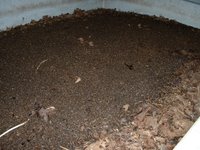Keeping the worms happy in the heat of summer
can be more of a challenge than that of winter!

As we move into the heat of summer, working the worm bin becomes a very delicate balance of keeping the bin aerated, moist, and fed. You want as little active composting going on as possible while still providing the worms with adequate nurishment. When the temperatures outside are in the nineties and climbing this can be a challenge.
I try to wait until the material in the bed has been worked very well by the worms. When I turn the bedding material, I will be incorporating air into the mix which will stimulate composting of any material that has yet to break down. In the picture below you can see the difference between the material that the worms have worked and that which they have not around the edges.

At the time of this working of the bins the temperatures here have been in the nineties. The bin I turned was reading a temperature of 81. The day after I turned it the temps went up to 97. That is actually too hot for the worms but by manipulating where the composting was taking place I am able to provide areas for the worms to go where they will be cooler. Since the bin is enclosed and the worms have no where else to go I absolutely need to do this or my worms will surely die.
The next picture shows the bin after the material has been turned. The worms have been disturbed and they really do not like this, but they are happy to have the air that is incorporated into the bedding material by this action.

The surface of the material will be rough and lumpy. I use a cultivator to break up the big clumps and smooth the area out.
Then a layer of food waste is spread down the center of the bin in a layer thick enough that you don't see the bedding material beneath it, but just. Don't put the food waste on too thick. Keep it to an area about 1/4 of the total surface area.

This is material my neighbor has saved for me and has been sitting in a bucket for about a week and smells pretty rank. I pour off any excess moisture before putting the material on the bed. If the material is covered properly with fresh bedding material then the smell will be covered as well and the worms will proceed to take care of it - smell and all.

The bedding material is horse manure that has been composting out in a designated area in my yard for over a year. The material is concentrated on top of the food waste down the center of the bin. As you can see it forms a mound of material on top of the food waste. The cable you see snaked across the top of the bin is the temperature probe. That is what tell me how hot the bin is. The probe is stuck down in the middle of the bin beneath the food waste. That is where it is reading 97 degrees.

The last thing I do is use my cultivator to smooth out the top of the fresh bedding to level it off some. I do not pull the material out to the edges of the bin. First off, the fresh material is dry and will take a few watering for the material to become saturated. The first couple of waterings the water just sloughs off. By leaving the area around the outside edges open the worms have friendly bedding material to come up into to feed and find cooler regions of the bin.
In no time at all (I was surprised that in this case the worms moved in to the fresh bedding overnight) the worms come back up to the surface to feed.





